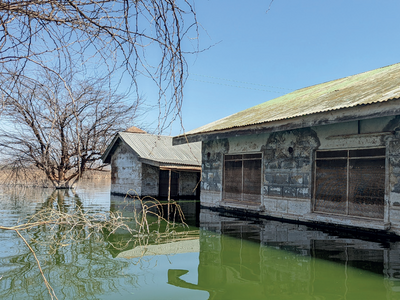

Several Kenyan lakes in the Rift Valley have experienced substantial water level increases since 2010, with alarming new rises recorded in 2024. Lake Baringo alone has risen by 3 meters between March and October 2024, continuing a concerning trend. These lakes, which form part of Kenya's biodiverse eco-zones and are classified as RAMSAR wetlands of international importance and UNESCO World Heritage Sites, are facing unprecedented challenges in their recorded history. The rising water levels have not only impacted biodiversity but have also inundated critical infrastructure, affecting schools, hospitals, national parks, and agricultural land. Current estimates indicate that approximately 80,000 households have been affected by these inundations.
Against this backdrop, researchers from the Technical University of Kenya (TUK) and the University of Natural Resources and Life Sciences, Vienna (BOKU) gathered with local stakeholders for a workshop at Tamarind Gardens, Kampi ya Samaki, on October 25, 2024. The workshop, part of the GreatLakes research project, brought together key stakeholders from the Water Resources Authority (WRA), Department of Environment and Climate Change of Baringo County, Kenya Wildlife Service (KWS), local chiefs, and community representatives to present and validate research findings on water level fluctuations and their implications for local communities.
During the workshop, researchers presented mounting scientific evidence regarding the causes of these rises. Dr. Mathew Herrnegger from BOKU University demonstrated with high probability that changes in rainfall and evapotranspiration characteristics - the major hydro-climatic drivers defining the water balance of the lakes - have driven the water level increases. Research revealed that mean annual rainfall increased by up to 30% across different lake catchments during 2010-2020, with even more dramatic increases of over 50% observed after 2018. Dr. Luke Olang from Technical University of Kenya presented a comprehensive policy brief on the water level rises, while Nelly Cherono shared critical findings on flood risk assessment for the Lake Baringo region. Gabriel Stecher discussed the potential overflow of Lake Bogoria into Lake Baringo, highlighting potential ecological risks.
During group discussions, valuable insights emerged from this diverse gathering of stakeholders. "Indigenous knowledge indicates that similar lake level rises occurred in 1960, causing significant infrastructure damage and vegetation loss," noted Joshua Chepsergon, the Lake Baringo Community Representative. Cheboswony Kendele, a hydrologist from WRA Kabarnet, presented the administrative perspective on lake level rises, providing crucial insights into water resource management challenges. Eng. Silas Kwonyike emphasized the need for integrated approaches to address these challenges, particularly focusing on sustainable land use management and enhanced cross-county cooperation.
Key recommendations from the workshop focused on investigating the role of siltation as a potential driver of rising lake levels, improving catchment meteorological forecasts, and enhancing knowledge transfer across stakeholders. The participants also emphasized the need for development of effective policies for managing trans-county rivers.
This study is performed within the project "Water Level Fluctuations and Implications on Local Livelihoods in the Great Rift Valley Lakes of Kenya | GreatLakes" (KOEF 08/2020), financed by the Austrian Federal Ministry of Education, Science and Research within the programme "Cooperation Development Research" and administered by OeAD-GmbH / Austria's Agency for Education and Internationalisation. The collaborative effort between international researchers and local stakeholders marks an important step toward addressing the complex challenges facing Kenya's Rift Valley lakes.
